怎样写英文病历
病历英语作文最简单三个步骤
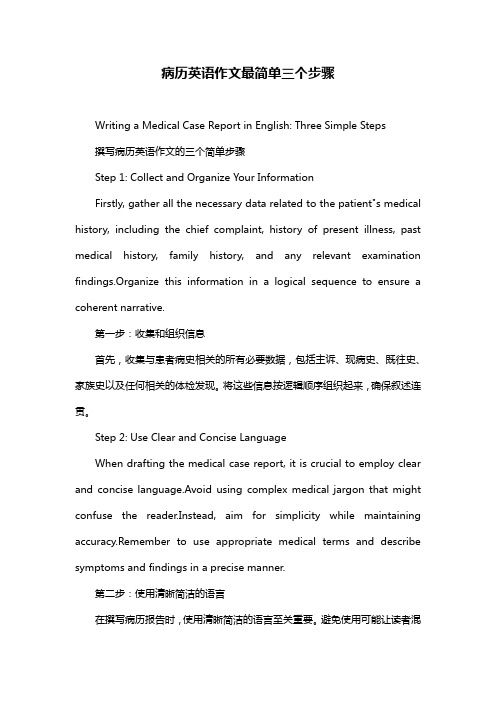
病历英语作文最简单三个步骤Writing a Medical Case Report in English: Three Simple Steps撰写病历英语作文的三个简单步骤Step 1: Collect and Organize Your InformationFirstly, gather all the necessary data related to the patient"s medical history, including the chief complaint, history of present illness, past medical history, family history, and any relevant examination anize this information in a logical sequence to ensure a coherent narrative.第一步:收集和组织信息首先,收集与患者病史相关的所有必要数据,包括主诉、现病史、既往史、家族史以及任何相关的体检发现。
将这些信息按逻辑顺序组织起来,确保叙述连贯。
Step 2: Use Clear and Concise LanguageWhen drafting the medical case report, it is crucial to employ clear and concise language.Avoid using complex medical jargon that might confuse the reader.Instead, aim for simplicity while maintaining accuracy.Remember to use appropriate medical terms and describe symptoms and findings in a precise manner.第二步:使用清晰简洁的语言在撰写病历报告时,使用清晰简洁的语言至关重要。
英语病历报告作文格式

英语病历报告作文格式Patient Medical Record Report.Patient Information:Full Name: John Doe.Gender: Male.Age: 45。
Address: 123 Main Street, City, State, Country.Contact Number: +1234567890。
Presenting Complaints:Mr. Doe presented with complaints of persistent chest pain, shortness of breath, and fatigue for the past two months. He reported a history of smoking for the past 20years and occasional alcohol consumption. There was no history of similar episodes in the past.Physical Examination:General: Mr. Doe appeared to be in moderate distress. His skin was pale, and there were no signs of jaundice or cyanosis.Cardiovascular: Heart rate was elevated at 100 beats per minute with irregular rhythm. Auscultation revealed a murmur in the mitral area.Respiratory: Breath sounds were diminished in the left lung base with evidence of crackles.Abdominal: Soft, non-tender abdomen with no organomegaly.Neurological: No focal neurological deficits were noted.Diagnostic Tests:Electrocardiogram (ECG): Showed irregular heartbeat with evidence of atrial fibrillation.Chest X-ray: Revealed enlarged heart with pulmonary congestion.Echocardiogram: Confirmed the presence of mitral valve regurgitation.Medical History:Mr. Doe had a history of hypertension for the past five years, which was well-controlled with medication. He had no known allergies to any medications. His family history was unremarkable for any cardiovascular diseases.Differential Diagnosis:Coronary Artery Disease (CAD)。
英语病历作文格式模板
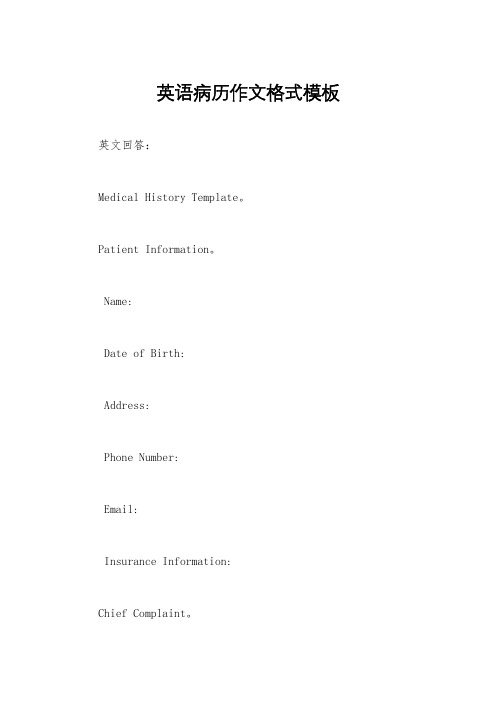
英语病历作文格式模板英文回答:Medical History Template。
Patient Information。
Name:Date of Birth:Address:Phone Number:Email:Insurance Information:Chief Complaint。
A brief summary of the patient's primary reason for the visit.Example: "The patient presents with a 3-day history of fever and chills."History of Present Illness。
A detailed description of the patient's symptoms, including:Onset: When did the symptoms first appear?Duration: How long have the symptoms been present?Severity: How severe are the symptoms?Location: Where are the symptoms located?Associated symptoms: Any other symptoms that are present, such as nausea, vomiting, or headache.Past Medical History。
A list of any previous medical conditions, surgeries, or hospitalizations.Example: "The patient has a history of hypertension and hyperlipidemia."Family History。
英文病历之主诉的写法

主诉1.主诉的表示方法:症状+时间(Symptom+T ime)•症状+for+时间如: [Chest pain for 2 hours] 胸痛2小时•症状+of+时间如: [Nausea and vomiting of three day s` duration] 恶心呕吐3天•症状+时间+in duration如: [Headache 1 month in duration] 头痛1月•时间+of+症状如: [Two-day history of fever] 发热2天2、常见症状• [Fever] 发热• [Pain] 疼痛• [Edema] 水肿• [Mucocutaneous hemorrhage (bleedin g)] 皮肤粘膜出血• [Dyspnea (Difficuly in breathing;Re spiratory difficulty;short of breath)]呼吸困难• [Cough and expectoration (Sputum;Ph legm)] 咳嗽和咯痰• [Hemoptysis] 咯血• [Cyanosis] 紫绀• [Palpitation] 心悸• [Chest discomfort] 胸闷• [Nausea (Retch;Dry Vomiting)and Vom iting] 恶心和呕吐• [Hematemesis (Vomiting of blood)]呕血• [Hematochezia (Hemafecia)] 便血• [Diarrhea] 腹泻• [Constipation (Obstipation)] 便秘• [Vertigo (Giddiness; Dizziness)] 眩晕• [Jaundice (Icterus)] 黄疸• [C onvulsion] 惊厥• [Disturbance of consciousness] 意识障碍• [Hematuria] 血尿• [Frequent micturition,urgent mictur ition and dysuria] 尿频,尿急和尿痛• [Incontinence of urine] 尿失禁• [Retention of urine] 尿潴留(1)发热的表示方法• [Infective (Septic)fever] 感染性发热• [Non-infective (Aseptic)fever] 非感染性发热• [Dehydration (Inanition)fever] 脱水热• [Drug fever] 药物热• [Functional hypothermia] 功能性低热• [Absorption fever] 吸收热• [Central fever] 中枢性发热• [Fever type] 热型▲ [Continuous fever] 稽留热▲ [Remittent fever] 驰张热▲ [Intermittent fever] 间歇热▲ [Undulant fever] 波状热▲ [Recurrent fever] 回归热▲ [Periodic fever] 周期热▲ [Irregular fever] 不规则热▲ [Ephemeral fever] 短暂热▲ [Double peaked fever] 双峰热• [Fever of undetermined(unknown) ori gin, FUO] 不明原因发热• [Rigor (shivering;chill;shaking chi ll;ague)] 寒战• [Chilly Sensation (Fell chilly;cold fits;coldness)] 畏寒[Ultra-hyperpyrexia] 超高热• [Hyperthermia (A high fever;hyperpy rexia;ardent fever)] 高热• [Moderate fever] 中度发热• [Hypothermia (Low-grade fever;sligh t fever;subfebrile temperature)] 低热• [Become feverish (Have a temperatur e)] 发热• [Crisis] 骤降• [Lysis] 渐降• [Typhoid fever] 伤寒热• [Rheumatic fever] 风湿热• [Cancerous fever] 癌性发热• [Fervescence period] 升热期• [Defervescence period] 退热期• [Persistent febrile period] 持续发热期(2)疼痛的表示方法• [Backache (Back pain)] 背痛• [Lumbago] 腰痛• [Headache] 头痛医学.全.在线.网.站.提供▲ [Vasomotor headache] 血管舒缩性头痛▲[Post-traumatic headache] 创伤后头痛▲[Migraine headache] 偏头痛▲ [Cluster headache] 丛集性头痛• [Chest pain] 胸痛• [Precardial pain] 心前区痛• [Retrosternal pain] 胸骨后痛• [Abdominal pain (Stomachache)] 腹痛• [Acrodynia (pain in limbs)] 肢体痛• [Arthrodynia (Arthralgia)] 关节痛[Dull pain] 钝痛•[Sharp pain] 锐痛•[Twinge pain] 刺痛•[Knife-like pain (Piercing pain)] 刀割(刺)样痛•[Aching pain] 酸痛•[Burning pain] 烧灼痛•[Colicky (Griping;cramp) pain] 绞痛•[Colic] 绞痛•[Bursting pain] 胀痛(撕裂痛)•[Hunger pain] 饥饿痛•[Tic pain] 抽搐痛•[Bearing-down pain] 坠痛•[Shock-like pain] 电击样痛•[Jumping pain] 反跳痛•[Tenderness pain] 触痛(压痛)•[Girdle-like pain] 束带样痛•[Wandering pain] 游走性痛•[Throbbing pain] 搏动性痛•[Radiating pain] 放射性痛•[Cramping pain] 痉挛性痛•[Boring pain] 钻痛•[Intense pain] 剧痛•[Writhing pain] 痛得打滚•[Dragging pain] 牵引痛•[Labor pain] 阵痛•[Cancerous pain] 癌性疼痛•[Referred pain] 牵涉痛•[Persistent pain (Unremitting pain)] 持续性痛•[Constant pain] 经常性痛•[Intermittent pain] 间歇性痛(3)水肿的表示方法[Mucous edema (Myxedema)] 粘液性水肿•[Cardiac (Cardiogenic) edema] 心源性水肿•[Nephrotic (renal) edema] 肾源性水肿•[Hepatic edema] 肝源性水肿•[Alimentary (Nutritional) edema] 营养不良性水肿•[Angioneurotic edema] 血管神经性水肿•[Pitting] 凹陷性•[Nonpitting] 非凹陷性•[Localized (Local) edema] 局限性水肿•[Generalized edema (Anasarca)] 全身性水肿•[Hydrops] 积水•[Elephantiasic crus] 橡皮肿•[Cerebral(Brain) edema] 脑水肿•[Pulmonary edema (Hydropneumonia0] 肺水肿•[Hydrocephalus] 脑积水医学全.在线网.站.提供•[Edema of endoscrinopathy] 内分泌病性水肿•[Invisible (Recessive) edema] 隐性水肿•[Frank edema] 显性水肿•[Inflammatory edema] 炎性水肿•[Idiopathic edema] 特发性水肿•[Cyclical edema] 周期性水肿•[Ascites (Abdominal effusion;hydroperiot oneum)] 腹水•[Pleural effusion (Hydrothorax)] 胸水•[Pericardial effusion (Hydropericardium)]心包积液•[Bronch oedema] 支气管水肿•[Slight (Mild)] 轻度•[Moderate] 中度•[Serious] 重度•[Transudate] 漏出液•[Exudate] 渗出液(4)呼吸困难的表示方法•[Cardiac dyspnea] 心原性呼吸困难•[Inspiratory] 吸气性•[Expiratory] 呼气性•[Mixed] 混合性•[Obstructive] 梗阻性•[Dyspnea at rest] 静息时呼吸困难•[Dyspnea on exertion] 活动时呼吸困难•[Dyspnea on lying down] 躺下时呼吸困难•[Paroxysmal nocturnal dyspnea,PND] 夜间阵发性呼吸困难•[Orthopnea] 端坐呼吸•[Asthma] 哮喘•[Cardiac asthma] 心源性哮喘•[Bronchial asthma] 支气管性哮喘•[Hyperpnea] 呼吸深快•[Periodic breathing] 周期性呼吸•[Tachypnea (Rapid or fast breathing;accel erated breathing;short of breath)]气促•[Bradypnea (Slow breathing)] 呼吸缓慢•[Irregular breathing] 不规则呼吸(5)皮肤粘膜出血的表示方法•[Bleeding spots in the skin] 皮肤出血点•[Petechia] 瘀点•[Eccymosis] 瘀斑•[Purpura] 紫癜•[Spl inter hemorrhage] 片状出血•[Oozing of the blood (Errhysis)] 渗血•[Blood blister (Hemophysallis)] 血疱•[Hemorrhinia (Nasal bleeding)] 鼻衄•[Ecchymoma] 皮下血肿(6)咳嗽与咯痰的表示方法•[Dry cough (Nonproductive cough;hackin g cough)] 干咳•[Sharp cough] 剧咳•[Wet cough (Moist cough)] 湿咳•[Productive cough (Loose cough)] 排痰性咳•[Chronic cough] 慢性咳嗽•[Irritable cough] 刺激性咳嗽•[Paroxysmal cough] 发作性(阵发性)咳嗽•[Cough continually] 持续性咳嗽•[Spasmodic cough] 痉挛性咳嗽•[Whooping cough] 百日咳•[Winter cough] 冬季咳•[Wheezing cough] 喘咳•[Short cough] 短咳•[Distressed cough] 难咳•[Shallow cough] 浅咳•[Droplet] 飞沫•[Frothy sputum] 泡沫样痰•[Bloody sputum] 血痰•[Mucous (Mucoid) sputum] 粘液样痰•[Purulent sputum] 脓痰•[Mucopurulent sputum] 粘液脓性痰•[White (Yellow,green) sputum] 白(黄,绿)痰[Fetid (Foul) sputum] 恶臭痰•[Iron-rust (Rusty) sputum] 铁锈色痰•[Chocolate coloured sputum] 巧克力色痰•[Thick sputum] 浓痰•[Thin sputum] 淡痰•[Viscous sputum] 粘痰•[Transparent sputum] 透明痰•[Much (Large amounts of) sputum] 大量痰•[Moderate amounts of sputum] 中等量痰•[Not much (Small amounts of ) sputum]少量痰(7)内脏出血的表示方法•[Goldstein’s hemoptysis]戈耳斯坦氏咯血•[Massive hematemesis]大量呕血•[Epistasis (Nosebleed;Nasal bleeding; He morrhinia;rhinorrhagia)]鼻衄•[Hematuria] 血尿•[Initial hematuria] 初血尿•[Idiopathic hematuria] 特发性血尿•[Painless hematuria] 无痛性血尿•[Terminal hematuria] 终末性血尿•[Gross (Macroscopic) hematuria] 肉眼血尿•[Microscopic hematuria] 镜下血尿•[Hematuria in the whole process of urin ation] 全程血尿•[Gingival bleeding (Ulaemorrhagia;gum b leeding)] 牙龈出血•[Hematochezia] 便血•[B loody stool] 血便•[Black stool (Melena)] 黑便•[Tarry stool] 柏油样便•[Bleeding following trauma] 外伤后出血•[Spontaneous bleeding] 自发性出血•[Bleeding Continuously] 持续出血•[Occult blood,OB] 隐血•[Hematobilia] 胆道出血•[Hemathorax] 血胸•[Hemarthrosis] 关节积血•[Hematocoelia] 腹腔积血•[Hematoma] 血肿•[Hemopericardium] 心包积血•[Cerebral hemorrhage] 脑出血•[Subarachnoid hemorrhage(SAH)] 蛛网膜下腔出血•[Excessive (Heavy) menstrual flow with passage of clots] 月经量多伴血块•[Mild (Moderate) menses] 月经量少(中等)•[Painless Vaginal bleeding] 无痛性阴道出血•[Postcoital bleeding] 性交后出血•[Pulsating bleeding] 搏动性出血•[Post-operation wound hemorrhage] 术后伤口出血•[Excessive bleeding after denal extractio n] 拔牙后出血过多(8)紫绀的表示方法•[Congenital cyanosis] 先天性紫绀•[Enterogenous] 肠源性•[Central] 中枢性•[Peripheral] 周围性[Mixed] 混合性•[Acrocyanosis] 指端紫绀(9)恶心与呕吐的表示方法•[V omiturition (Retching)] 干呕•[Feel nauseated] 恶心感•[Postprandial nausea] 饭后恶心•[Hiccup] 呃逆•[Sour regurgitation] 返酸•[Fecal (Stercoraceous) vomiting] 吐粪•[undigested food Vomiting] 吐不消化食物•[Bilious Vomiting] 吐胆汁(10)腹泻与便秘的表示方法•[Moning diarrhea] 晨泻•[Watery (Liquid)diarrhea] 水泻•[Mucous diarrhea] 粘液泻•[Fatty diarrhea] 脂肪泻•[Chronic (Acute)] 慢性(急性)•[Mild diarrhea] 轻度腹泻•[Intractable (Uncontrolled)diarrhea] 难治性腹泻•[Protracted diarrhea] 迁延性腹泻•[Bloody stool] 血梗•[Frothy stool] 泡沫样便•[Formless (Formed)stool] 不成形(成形)便•[Loose (Hard) stool] 稀(硬)便•[Rice-water stool] 米泔样便•[Undigested stool] 不消化便•[Dysenteric diarrhea] 痢疾样腹泻•[Inflammatory diarrhea] 炎症性腹泻•[Osmotic] 渗透性[Secretory] 分泌性•[Malabsorption] 吸收不良性•[Lienteric] 消化不良性•[Pancreatic diarrhea] 胰性腹泻•[Tenesmus] 里急后重•[Pass a stool (Have a passage; open or relax the bowel)] 解大便•[Have a call of nature] 便意•[Fecal incontinence (Copracrasia)] 大便失禁•[Functional constipation] 功能性便秘•[Organic constipation] 器质性便秘•[Habitual constipation] 习惯性便秘•[Have a tendency to be constipated] 便秘倾向(11)黄疸的表示方法•[Latent (occult) jaundice] 隐性黄疸•[Clinical jaundice] 显性黄疸•[Nuclear icterus] 核黄疸•[Physiologic icterus] 生理性黄疸•[Icterus simplex] 传染性黄疸•[Toxemic icterus] 中毒性黄疸•[Hemolytic] 溶血性•[Hepatocellular] 肝细胞性•[Obstructive] 阻塞性•[Congenital] 先天性•[Familial] 家族性•[Cholestatic] 胆汁淤积性•[Hematogenous] 血源性•[Malignant] 恶性•[Painless] 无痛性(12)意识障碍的表示方法[Somnolence] 嗜睡•[Confusion] 意识模糊•[Stupor] 昏睡•[Coma] 昏迷•[Delirium] 谵妄•[Syncope (swoon; faint)] 晕厥•[Drowsiness] 倦睡(13)排尿的表示方法•[Enuresis (Bed-wetting)] 遗尿•[Anuria] 无尿•[Emiction interruption] 排尿中断•[Interruption of urinary stream] 尿线中断•[Nocturia] 夜尿•[Oliguria] 少尿•[Polyuria] 多尿•[Pass water (Make water; urinate; mictur ition)] 排尿•[Frequent micturition (Frequency of mict urition; fruquent urination; Pollakiuria)] 尿频•[Urgent micturition (Urgency of urination or micturition)] 尿急•[Urodynia (Pain on micturition; painful micturition; alginuresis; micturition pain)] 尿痛•[Dysuria (Difficulty in micturition; distur bance of micturition)] 排尿困难•[Small urinary stream] 尿线细小•[V oid with a good stream] 排尿通畅•[Guttate emiction (Dribbling following ur ination;terminal d ribbling)] 滴尿•[Bifurcation of urination] 尿流分叉•[Residual urine] 残余尿•[Extravasation of urine] 尿外渗•[Stress incontinence] 压力性尿失禁•[Overflow incontinence] 溢出性尿失禁•[Paradoxical in continence] 反常性尿失禁3.少见症状•[Weekness( Debility; asthenia; debilitatin g)] 虚弱(无力)•[Fatigue (Tire; lassitude)] 疲乏•[Discomfort (Indisposition; malaise)] 不适•[Wasting (thin; underweight; emaciation; lean)] 消瘦•[Night sweating] 盗汗•[Sweat (Perspiration)] 出汗•[Cold sweat] 冷汗•[Pruritus (Iching)] 搔痒•[Asthma] 气喘•[Squeezing (Tightness; choking; pressing) sensation of the chest] 胸部紧缩(压榨)感•[Intermittent claudication] 间歇性跛行•[Difficulty in swallowing( Dysphagia; dif ficult swallowing; acataposis)] 吞咽困难•[Epigastric (Upper abdominal) discomfort]上腹部不适•[Anorexia (Sitophobia)] 厌食•[Poor appetite (Loss of appe tite)] 纳差•[Heart-burn( Pyrosis)] 胃灼热•[Stomachache( Pain in stomach)] 胃部痛•[Periumbilial pain] 脐周痛•[Belching (Eructation)] 嗳气•[Sour regurgitation] 返酸•[Abdominal distention(bloating)] 腹胀•[Pass gas( Break wink)] 肛门排气•[Small(Large) stool] 大便少(多)•[Expel(Pass) worms] 排虫•[Pain over the liver] 肝区痛•[Lumbago] 腰痛•[Pica(Parorexia; allotriophagy)] 异食癖•[Dysmenorrhea] 痛经•[Menoxenia (Irregular menstruation)] 月经不调•[Polymenorrhea (Epimenorrhea)] 月经过频•[Oligomenorrhea] 月经过少医学全.在线提供•[Excessive menstruation (Menorrhagia; m enometrorrhagia; hypermenorrhea)] 经量过多•[Hypomenorrhea (Scantymenstruation)] 经量过少•[Menopause (Menostasia; menostasis)] 绝经•[Amenorrhea (Menoschesis)] 闭经•[Leukorrhagia] 白带过多•[Asexuality (lack of libido)] 无性欲•[Hyposexuality] 性欲低下•[Hype rsexuality] 性欲亢进•[Prospermia (Ejaculatio praecox)] 早泄•[Impotency (impotence)] 阳萎•[Nocturnal emission (Spermatorrhea)] 遗精•[Lack of potency] 无性交能力•[Hair loss] 脱发•[Joint pain (Arthralgia; arthrodynia)] 关节痛•[Polydipsia (Excessive thirst)] 多饮(烦渴)•[Polyphagia (Excessive appetite; hyperore xia; bulimia)] 多食•[Cold (Heat) intolerance] 怕冷(热)•[Dwarfism (Excessive height)] 身材矮小(高大)•[Excessive sweating] 多汗•[Hands tremble] 手抖•[Obesity (Fatty)] 肥胖•[Agitation (Anxiety;nervous irritability)] 焦虑(忧虑)•[Mania] 躁狂•[Hallucination] 幻觉•[Aphasia (Logopathy)] 失语•[Amnesia (Poor memorization;memory de terioration)] 记忆力下降•[Hemianesthesia] 偏身麻木•[Formication] 蚁走感•[Tingling] 麻刺感•[Hyperpathia] 痛觉过敏•[Hypalgesia] 痛觉减退•[Illusion] 错觉•[Hemiplegia] 半身不遂[Insomnia (Poor sleepness;sleeplessness)] 失眠•[Nightmare] 多梦•[Numbness] 麻木•[Pain in limbs (Acrodynia)] 肢体痛•[Limitation of motion] 活动受限•[Tetany] 手足抽搐•[Discharge of pus] 流脓•[Blurred vision(Hazy vision;blurring of v ision; dimness of vision)]视物模糊•[Burning (Dry) sensation] 烧灼(干燥)感•[Tearing (Dacryorrhea;Lacrimation)] 流泪•[Double vision (Diplopia)] 复视•[Strabismus] 斜视•[Hemianopia] 偏盲•[Tired eyes (Eyestrain)] 眼疲劳•[Foreign body sensation] 异物感•[Lose the sight (Lose of vision)] 失明•[Diminution of vision] 视力减退•[Nictition] 眨眼•[Ophthalmodynia (Eye-ache;ocular pain)]眼痛•[Photophobia] 畏光•[Spots before the eyes] 眼前黑点•[Deafness(Anacusia)] 耳聋•[Auditory dysesthesia] 听力减退•[Otalgia (Otodynia;pain in the ear ;ear-ac he)] 耳痛•[Stuffy feeling in the ear] 耳闭气•[Tinnitus] 耳鸣医学全在.线提供•[Outophony] 自声过强•[Nasal obstruction (blockage)] 鼻塞•[Dryness of the nose] 鼻干燥•[Rhinorrhea (Snivel;Nasal discharge)] 流鼻涕•[Sneezing] 打喷嚏•[Snoring] 打鼾•[Hyposmia (Reduction of the sense of s mell)] 嗅觉减退•[Anosmia (Complete loss of sense of sm ell)] 嗅觉丧失•[Dysphonia] 发音困难•[Hoarseness] 声嘶•[Pain on swallowing] 吞咽痛•[Saliva dribblies from the mouth] 流涎•[Troaty voice] 声音沙哑•[Stridor] 喘鸣•[Red and swollen] 红肿•[Scurf] 头皮屑•[Show] 见红•[Amniotic fluid escaped] 破水•[Uterine contraction] 宫缩•[Acalculia] 计算不能•[Apathy] 情感淡漠•[Delusion] 妄想4、时间的表示方法(1)月(Month)•[January,Jan.] 一月•[February,Feb.] 二月•[March,Mar.] 三月•[April,Apr.] 四月•[May] 五月•[June,Jun.] 六月•[July,Jul.] 七月•[August,Aug.] 八月•[September,Sept.] 九月•[October,Oct.] 十月•[November,Nov.] 十一月•[December,Dec.] 十二月(2)周(Week)• [Monday] 星期一• [Tuesday] 星期二• [Wednesday] 星期三• [Thursday] 星期四• [Friday] 星期五• [Saturday] 星期六• [Sunday] 星期日(3)年(Year)和日[Day]•[1st (First) year] 第1年•[2nd (Second) year] 第2年•[3rd (Third)year] 第3年•[4th (Forth) year] 第4年•[One year (day)] 1年(天)•[Two years (days)] 2年(天)•[Whole year] 整年•[1st (First)] 1日•[2rd (Second)] 2日•[3rd (Third)] 3日•[5th (Fifth)] 5日•[Today] 今天•明天[Tomorrow]•昨天[Yesterday]•前天[The day bdfore yesterday]•后天[The day after tomorrow]•大前天[3 days ago]•大后天[3 days hence]•今晚[Tonight]•昨晚[Last night]•明晚[Next nigh t]•通宵[All night]•整天[All day (the whole day)](4)季节[Season]和时节[Solar terms] •春季[Spring]•夏季[Summer]•秋季[Autumn]•冬季[Winter]•立春(夏、秋、冬)[the Beginning of Spi ring (Summer;Autumn;Winter)]•小暑(雪、寒)[Slight Heat (Snow;Cold)] •大暑(雪、寒)[Great Heat (Snow;Cold)] •雨水[Rain Water]•惊蛰[the Waking of Insects]•春(秋)分[the Spiring (Autumnal) Equin ox]•清明[Pure Brightness]•谷雨[Grain Rain]•小满[Grain Full]•芒种[Grain in Ear]•夏(冬至)[the Summer (Winter) Solstice] •处暑[the Limit of Heat]•白(寒)露[White (Cold) Dew]•霜降[Frost’s Descent](5)时间的表示方法•In[在……内(后)]▲在2003年[In 2003]▲在3月[In March(Mar.)]▲在去年10月[In last Oct.]▲在早晨[In the morning]▲在上午[In the forenoon]▲在下午[In the afternoon]▲在晚上[In the evening]▲在近5天[In the past 5 days]▲在10分钟后[In 10 minutes]▲在秋季[In autumn]▲在这2~3天内[In a couple of days]•Within[在……中]▲在近8个月中[Within the last 8 mont hs]▲在过去的2年中[Within the preceding 2 years]•On[在……时候]医学全在.线提供www. ▲在2002的9月18日[On the 18th of September,2002(英国)or On sept.18th,2002 (美国)▲在星期三[On Wednesday]▲在本月7日[On 7th instant]•At[在……时]▲在中午[At noon]▲在晚上[At night]▲在昨晚[At last (preceding;previous )ni ght]▲在半夜[At midnight]▲在上午10点钟[At 10AM]▲在5岁时[At the age of five]▲在2000年底(中、初)[At the end (mid dle;beginning) of 2000]•For[计……时间]▲一周[For one week]▲近2个月来[For the past 2 months]▲几乎(整整)一年[For nearly a mont h (a full month)]▲3个月左右[For 3 months or so]▲至少3个月[For at least 3 months]▲3个月以上[For more than 3 months]▲3个月或以上[For 3months or more]▲时间不详[For an unknown(indefinite) period (time)]•Of[在……时期]▲10年内[Of 10 years` duration]▲期间[Length of time]▲6月6日[The 6th of June]•Dring[在……期间]▲在2000-2005年的几年中[During the y ears form 2000 to 2005]▲在这4年中[During four years]▲在过去的几周中[During the past(Last) couple of weeks]▲在夜间[Dur ing the night]▲整天[During the entire day]•About [约]▲约1个半小时[About one and half an hour]▲大约半年[About half a year]•To[至;在……之前]▲从今下午点至明上午8点[Form 6 PM today to 8 AM tomorrow]▲6点45分[At fifteen to seven]•From[从……起]▲从14岁至52岁[From 14 to 52 year-old]▲从上午7点30分开始[Form 7:30AM] ▲从周一至周五[From Monday through Friday]•Past[过去;超过]▲在过去的3周中[In the past 3 weeks] ▲8点10分[ten minutes past eight]•Through or throughout[在……整个期间] ▲通宵值班[Be on duty through the nig ht]▲从一月到六月[From January through June]▲熬过明晚[Through the next nigut]▲整天(晚)[Throughout the day (night)] •Over[在……期间]▲在过去的2个月内[Over the past t wo months]▲一夜间[Overnight](6)其他表示方法•每月(年、日)一次[Monthly (Yearly; dai ly)]•整整一年[Yearlong (Year-round)]•满周岁[Yearling]•工作日[Weekday]•周末[Weekend]•每周末[Weekends]•8小时工作日[An eight-hour day]•整天[Daylong]•白天[Daytime]•昼夜[Nighttime]•日常的[Day-to-day]•夏令时间[Daylight saving time]•每晚[Nightly]•黄昏[Nighfall]•过期的[Overdue]•前天晚上(一夜间)[Overnight]•After [在……之后]▲婚后[After one`s marriage]▲七点十分[Ten after (past) seven]▲住(出)院后[After admission (discharge)] ▲起病后2天[2 days after the onset(attack) of symptoms]•Before[在……之前]▲ 7点50分之前[Before seven fifty]▲医生到达前[Before the doctor come]▲以前未有种症状[Have had not the same symptom before]Ago[以前]▲ 5年前[5 years ago]▲直到一个月前[Up to one month ago]▲大前天[Three days ago]•Prior to[在……之前]▲入(出)院前[Prior to admission (discha rge)]▲前天之前[Prior to the day before yester day]•Up to[直到]▲直到3周前[Up to 3 weeks ago]▲直到现在(出院)[Up to now (discharge)] •Until or till[直到]▲直到80岁[Until 80 years old]▲直到今晨8点[Until 8 o`clock this moni ng]▲直到医生查完房[Until the doctor have f inished the ward round]▲直到3年以前[Until 3 years ago]▲直到出院前一天[Until 1 day prior to di scharge]•By[在……之前] ▲下午点钟前[By 5 PM] ▲下个月之前[By next month]•Since[从……开始]▲自从去年术后[Since operation was perfo rmed last year]▲前天起[Since the day before yesterday] ▲从2002年6月起[Since June 2002]•超时(加班)[Overtime]•上午8点[8:00AM]•下午2点30分[2:30PM]•7点50分[Seven fifty (Ten to eight)]•9点20分[Nine twenty(Twenty past or aft er nine)]术前[Pre-operation]•术后[Post-operation]现病史[History of present illness 现病史书写的重点包括:一、主诉中症状的详细描述;二、疾病的发展过程;三、诊疗经过;四、目前的一般情况。
英文病历书写范例

英文病历书写范例(内科)Medical Records for AdmissonMedical Number: 701721General informationName: Liu SideAge: EightySex: MaleRace: HanNationality: ChinaAddress: NO.35, Dandong Road, Jiefang Rvenue, Hankou, Hubei.Tel: 857307523Occupation: RetiredMarital status: MarriedDate of admission: Aug 6th, 2001Date of record: 11Am, Aug 6th, 2001Complainer of history:patient’s son and wifeReliability: ReliableChief complaint: Upper bellyache ten days, haematemesis, hemafecia and unconsciousness for fo ur hours.Present illness:The patient felt upper bellyache about ten days ago. He didn’t pay attention to it and thought heha date something wrong. At 6 o’cloc k this morning he fainted and rejected lots of blood and gore. T hen hemafecia began. His family sent him to our hospital and received emergent treatment. So the patient was accepted because of “upper gastrointestine hemorrhage and exsanguine shock”. Since the disease coming on, the patient didn’t urinate. Past historyThe patient is healthy before.No history of infective diseases. No allergy history of food and drugs.Past history Operative history: Never undergoing any operation. Infectious history: No history of s evere infectious disease. Allergic history: He was not allergic to penicillin or sulfamide. Respirator y system: No history of respiratory disease. Circulatory system: No history of precordial pain. Ali mentary system: No history of regurgitation.Genitourinary system: No history of genitourinary disease.Hematopoietic system: No history of anemia and mucocutaneous bleeding. Endocrine system: No acromegaly. No excessive sweats. Kinetic system: No history of confinement of limbs. Neural sys tem: No history of headache or dizziness. Personal historyHe was born in Wuhan on Nov 19th, 1921 and almost always lived in Wuhan. His living condition s were good. No bad personal habits and customs.Menstrual history: He is a male patient. Obstetrical history: NoContraceptive history: Not clear.Family history: His parents have both deads. Physical examinationT 36.5℃, P 130/min, R 23/min, BP 100/60mmHg. He is well developed and moderately nourished.Active position. His consciousness was not clear. His face was cadaverous and the skin was not sta ined yellow. No cyanosis. No pigmentation. No skin eruption. Spider angioma was not seen. No pi tting edema. Superficial lymph nodes were not found enlarged. HeadCranium: Hair was black and white, well distributed. No deformities. No scars. No masses. No ten derness.Ear: Bilateral auricles were symmetric and of no masses. No discharges were found in external au ditory canals. No tenderness in mastoid area. Auditory acuity was normal.Nose: No abnormal discharges were found in vetibulum nasi. Septum nasi was in midline. No nare s flaring. No tenderness in nasal sinuses. Eye: Bilateral eyelids were not swelling. No ptosis. No e ntropion. Conjunctiva was not congestive. Sclera was anicteric. Eyeballs were not projected or dep ressed. Movement was normal. Bilateral pupils were round and equal in size. Direct and indirect p upillary reactions to light were existent.Mouth: Oral mucous membrane was not smooth, and there were ulcer can be seen. Tongue was in midline. Pharynx was congestive. Tonsils were not enlarged.Neck: Symmetric and of no deformities. No masses. Thyroid was not enlarged. Trachea was in mi dline. ChestChestwall: Veins could not be seen easily. No subcutaneous emphysema. Intercostal space was nei ther narrowed nor widened. No tenderness.Thorax: Symmetric bilaterally. No deformities. Breast: Symmetric bilaterally.Lungs: Respiratory movement was bilaterally symmetric with the frequency of 23/min. thoracic e xpansion and tactile fremitus were symmetric bilaterally. No pleural friction fremitus. Resonance was heard during percussion. No abnormal breath sound was heard. No wheezes. No rales. Heart: No bulge and no abnormal impulse or thrills in precordial area. The point of maximum imp ulse was in 5th left intercostal space inside of the mid clavicular line and not diffuse. No pericardi al friction sound. Border of the heart was normal. Heart sounds were strong and no splitting. Rate 150/min. Cardiac rhythm was not regular. No pathological murmurs.Abdomen: Flat and soft. No bulge or depression. No abdominal wall varicosis. Gastralintestinal ty pe or peristalses were not seen. Tenderness was obvious around the navel and in upper abdoman. T here was not rebound tenderness on abdomen or renal region. Liver and spleen was untouched. No masses. Fluidthrill negative. Shifting dullness negative. Borhorygmus not heard. No vascular mur murs. Extremities: No articular swelling. Free movements of all limbs.Neural system: Physiological reflexes were existent without any pathological ones. Genitourinary system: Not examed. Rectum: not exanedInvestigationBlood-Rt: Hb 69g/L RBC 2.70T/L WBC 1. 1G/L PLT 120G/L History summary1. Patient was male, 80 years old2. Upper bellyache ten days, haematemesis, hemafecia and unconsciousness for four hours.3. No special past history.4. Physical examination: T 37.5℃, P 130/min, R 23/min, BP 100/60mmHg Superficial lymph node s were not found enlarged. No abdominal wall varicosis. Gastralintestinal type or peristalses were not seen. Tenderness was obvious around the navel and in upper abdoman. There was not rebound tenderness on abdomen or renal region. Liver and spleen was untouched. No masses. Fluidthrill ne gative. Shifting dullness negative. Borhorygmus not heard. No vascular murmurs. No other positive signs. 5. investigation information:Blood-Rt: Hb 69g/L RBC 2.80T/L WBC 1.1G/L PLT 120G/LImpression: upper gastrointestine hemorrhage Exsanguine shock出院小结(DISCHARGE SUMMARY), ===============Department of GastroenterologyChanghai Hospital,No.174 Changhai Road Shanghai, China Phone: 86-21-25074725-803 DISCHARGE SUMMARYDA TE OF ADMISSION: October 7th, 2005 DA TE OF DISCHARGE: October 12th, 2005 ATTE NDING PHYSICIAN: Yu Bai, MD PA TIENT AGE: 18ADMITTING DIAGNOSIS:V omiting for unknown reason: acute gastroenteritis?BRIEF HISTORYA 18-year-old female with a complaint of nausea and vomiting for nearly one month who was see n at Department of Gastroenterology in Changhai Hospital, found to have acute gastroenteritis and non-atrophic gastritis. The patient was subsequently recovered and discharged soon after medicati on.REVIEW OF SYSTEMShe has had no headache, fever, chills, diarrhea, chest pain, palpitations, dyspnea, cough, hemopty sis, dysuria, hematuria or ankle edema.PAST MEDICAL HISTORYShe has had no previous surgery, accidents or childhood illness.SOCIAL HISTORY: She has no history of excessive alcohol or tobacco use.FAMIL Y HISTORYShe has no family history of cardiovascular, respiratary and gastrointestinal diseases. PHYSICAL EXAMINA TIONTemperature is 37, pulse 80, respirations 16, blood pressure 112/70. General: Plump girl in no app arent distress. HEENT: She has no scalp lesions. Her pupils are equally round and reactive to light and accommodation. Extraocular movements are intact. Sclerae are anicteric. Oropharynx is clear. There is no thyromegaly. There is no cervical or supraclvicular lymphadenopathy. Cardiovascular: Regular rate andrhythm, normal S1, S2. Chest: Clear to auscultation bilateral. Abdomen: Bowel sounds present, no hepatosplenomagaly. Extremities: There is no cyanosis, clubbing or edema. Neurologic: Cranial n erves II-XII are intact. Motor examination is 5/5 in the bilateral upper and lower extremities. Sens ory, cerebellar and gait are normal.LABORATORY DATAWhite blood cells count 5.9, hemoglobin 111g/L, hematocrit 35.4. Sodium 142, potassium 4.3, chl oride 106, CO2 25, BUN 2.6mmol/L, creatinine 57μmol/L, glucose 4.1mmol/L, Albumin 36g/L. Endoscopic ExamChronic non-atrophic gastritisHOSPITAL COURSEThe patient was admitted and placed on fluid rehydration and mineral supplement. The patient im proved, showing gradual resolution of nausea and vomiting. The patient was discharged in stable c ondition.DISCHARGE DIAGNOSIS Acute gastroenteritisChronic non-atrophic gastritisPROGNOSISGood. No medications needed after discharge. But if this patient can not get used to Chinese food, she had better return to UK as soon as possible to prevent the relapse of acute gastroenteritis. The patient is to follow up with Dr. Bai in one week. ___________________________ Yu Bai, MD D: 12/10/2005。
英文病例写作范文阅读带翻译
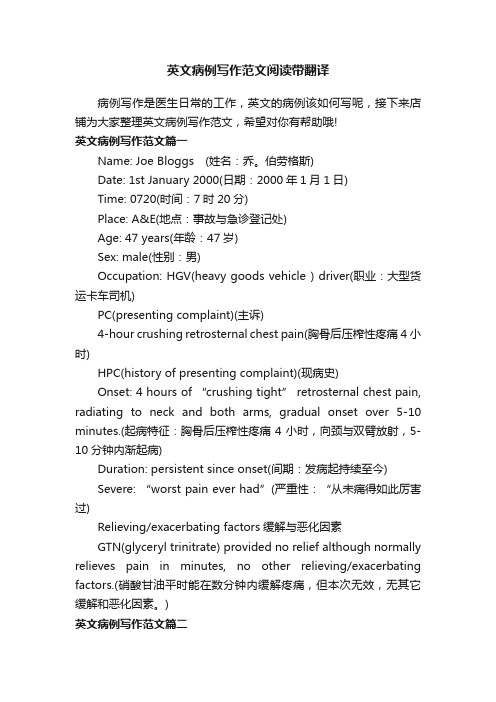
英文病例写作范文阅读带翻译病例写作是医生日常的工作,英文的病例该如何写呢,接下来店铺为大家整理英文病例写作范文,希望对你有帮助哦!英文病例写作范文篇一Name: Joe Bloggs (姓名:乔。
伯劳格斯)Date: 1st January 2000(日期:2000年1月1日)Time: 0720(时间:7时20分)Place: A&E(地点:事故与急诊登记处)Age: 47 years(年龄:47岁)Sex: male(性别:男)Occupation: HGV(heavy goods vehicle ) driver(职业:大型货运卡车司机)PC(presenting complaint)(主诉)4-hour crushing retrosternal chest pain(胸骨后压榨性疼痛4小时)HPC(history of presenting complaint)(现病史)Onset: 4 hours of “crushing tight” retrosternal chest pain, radiating to neck and both arms, gradual onset over 5-10 minutes.(起病特征:胸骨后压榨性疼痛4小时,向颈与双臂放射,5-10分钟内渐起病)Duration: persistent since onset(间期:发病起持续至今)Severe: “worst pain ever had”(严重性:“从未痛得如此厉害过)Relieving/exacerbating factors缓解与恶化因素GTN(glyceryl trinitrate) provided no relief although normally relieves pain in minutes, no other relieving/exacerbating factors.(硝酸甘油平时能在数分钟内缓解疼痛,但本次无效,无其它缓解和恶化因素。
英文病历报告作文模板
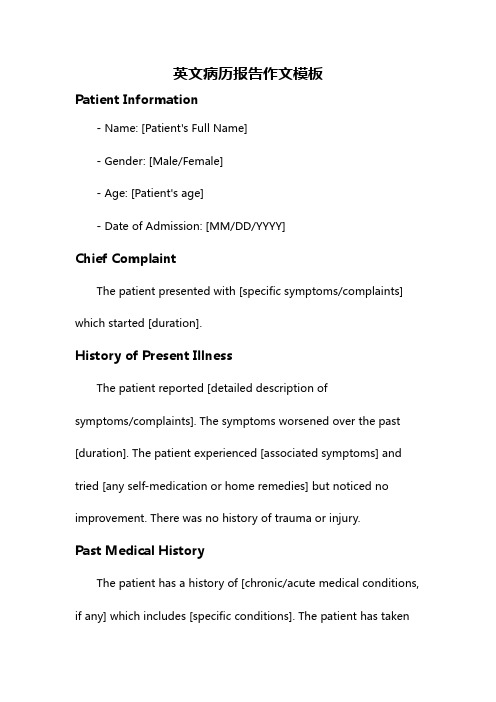
英文病历报告作文模板Patient Information- Name: [Patient's Full Name]- Gender: [Male/Female]- Age: [Patient's age]- Date of Admission: [MM/DD/YYYY]Chief ComplaintThe patient presented with [specific symptoms/complaints] which started [duration].History of Present IllnessThe patient reported [detailed description ofsymptoms/complaints]. The symptoms worsened over the past [duration]. The patient experienced [associated symptoms] and tried [any self-medication or home remedies] but noticed no improvement. There was no history of trauma or injury.Past Medical HistoryThe patient has a history of [chronic/acute medical conditions, if any] which includes [specific conditions]. The patient has taken[previous medications/treatments] for these conditions.Social HistoryThe patient has a [specific occupation] and lives in [specific area]. The patient does [specific habits] such as smoking or drinking alcohol [frequency]. There is no significant family medical history.Physical Examination- Vital Signs:- Blood Pressure: [value] mmHg- Heart Rate: [value] bpm- Respiratory Rate: [value] bpm- Temperature: [value]C- General Appearance:The patient appears [general appearance of the patient].- Systemic Examination:- Cardiovascular: [specific findings]- Respiratory: [specific findings]- Gastrointestinal: [specific findings]- Neurological: [specific findings]- Musculoskeletal: [specific findings]Laboratory and Imaging Findings- Blood Test Results:- Complete Blood Count: [values]- Biochemical Profile: [values]- Others: [specific findings]- Imaging:- [Specific imaging tests performed]- Results: [specific findings]DiagnosisAfter evaluating the patient's medical history, physical examination, and laboratory/imaging findings, the following diagnosis was made:[Primary Diagnosis]Treatment and ManagementThe patient was started on [specific treatment plan] which includes [medications, therapies, or procedures]. The patient wasadvised to [specific instructions] and scheduled for [follow-up tests/appointments, if any].Follow-upThe patient will be followed up in [specific time frame] to assess the response to treatment and manage any complications that may arise. The patient was given contact information for any urgent concerns or changes in symptoms.Discussion and ConclusionThis case report highlights the presentation, evaluation, and management of a patient with [specific condition]. The patient's symptoms were appropriately addressed through a systematic approach involving history taking, physical examination, and laboratory/imaging investigations. The provided treatment plan aims to address the underlying cause and improve the patient's overall well-being. Continuous monitoring and follow-up will guide further management decisions.Note: This medical case report is fictional and serves as a template for educational purposes. Any resemblance to actualpatients is purely coincidental.。
医学英语病历书写重点
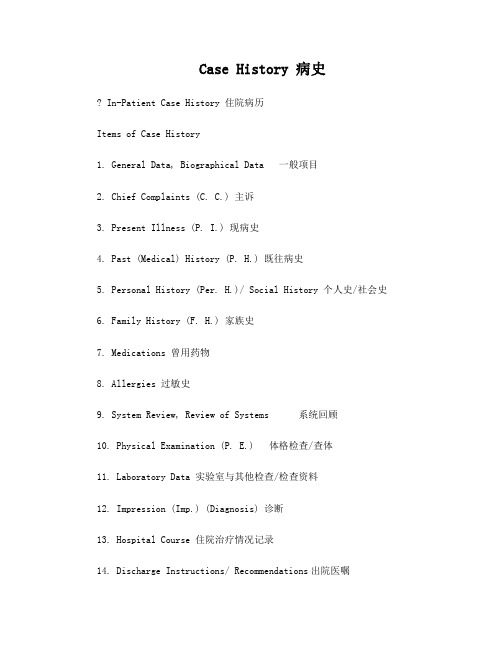
Case History 病史In-Patient Case History 住院病历Items of Case History1. General Data, Biographical Data 一般项目2. Chief Complaints (C. C.) 主诉3. Present Illness (P. I.) 现病史4. Past (Medical) History (P. H.) 既往病史5. Personal History (Per. H.)/ Social History 个人史/社会史6. Family History (F. H.) 家族史7. Medications 曾用药物8. Allergies 过敏史9. System Review, Review of Systems 系统回顾10. Physical Examination (P. E.) 体格检查/查体11. Laboratory Data 实验室与其他检查/检查资料12. Impression (Imp.) (Diagnosis) 诊断13. Hospital Course 住院治疗情况记录14. Discharge Instructions/ Recommendations出院医嘱15. Discharge Medications 出院后用药General Data, Biographical Data 一般项目Reliability (病历可靠性):Reliable(可靠)/ Not Entirely(不完全可靠)/Not Clearly Defined (不够准确)/Confused and Uncertain (混乱不清)/ Unobtainable (无法获得)Supplier/ Complainer of History (供史者/病史陈述者):Patient/ Husband/ Wife/ Father/ Mother/ Colleague/ NeighborChief Complaints (C. C.) 主诉: 病例重要部分之一,通常包括患者年龄、简要的相关的既往史、患者的就诊原因及目前症状持续的时间等。
英文病例书写
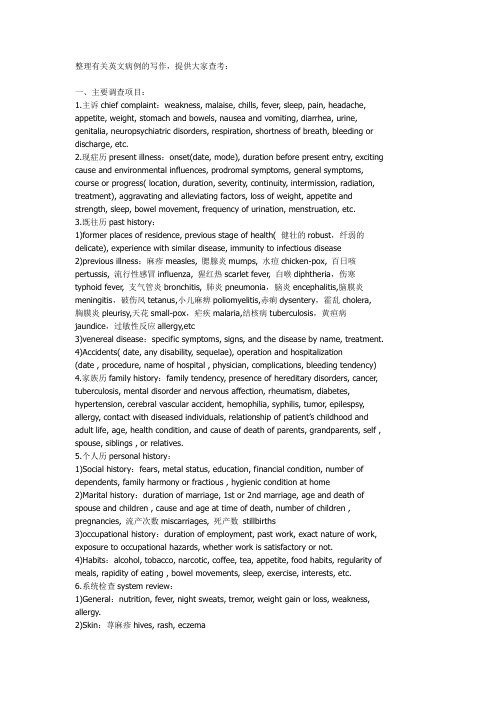
整理有关英文病例的写作,提供大家查考:一、主要调查项目:1.主诉chief complaint:weakness, malaise, chills, fever, sleep, pain, headache, appetite, weight, stomach and bowels, nausea and vomiting, diarrhea, urine, genitalia, neuropsychiatric disorders, respiration, shortness of breath, bleeding or discharge, etc.2.现症历present illness:onset(date, mode), duration before present entry, exciting cause and environmental influences, prodromal symptoms, general symptoms, course or progress( location, duration, severity, continuity, intermission, radiation, treatment), aggravating and alleviating factors, loss of weight, appetite and strength, sleep, bowel movement, frequency of urination, menstruation, etc.3.既往历past history:1)former places of residence, previous stage of health( 健壮的robust,纤弱的delicate), experience with similar disease, immunity to infectious disease2)previous illness:麻疹measles, 腮腺炎mumps, 水痘chicken-pox, 百日咳pertussis, 流行性感冒influenza, 猩红热scarlet fever, 白喉diphtheria,伤寒typhoid fever, 支气管炎bronchitis, 肺炎pneumonia,脑炎encephalitis,脑膜炎meningitis,破伤风tetanus,小儿麻痹poliomyelitis,赤痢dysentery,霍乱cholera,胸膜炎pleurisy,天花small-pox,疟疾malaria,结核病tuberculosis,黄疸病jaundice,过敏性反应allergy,etc3)venereal disease:specific symptoms, signs, and the disease by name, treatment.4)Accidents( date, any disability, sequelae), operation and hospitalization(date , procedure, name of hospital , physician, complications, bleeding tendency) 4.家族历family history:family tendency, presence of hereditary disorders, cancer, tuberculosis, mental disorder and nervous affection, rheumatism, diabetes, hypertension, cerebral vascular accident, hemophilia, syphilis, tumor, epilespsy, allergy, contact with diseased individuals, relationship of patient’s childhood and adult life, age, health condition, and cause of death of parents, grandparents, self , spouse, siblings , or relatives.5.个人历personal history:1)Social history:fears, metal status, education, financial condition, number of dependents, family harmony or fractious , hygienic condition at home2)Marital history:duration of marriage, 1st or 2nd marriage, age and death of spouse and children , cause and age at time of death, number of children , pregnancies, 流产次数miscarriages, 死产数stillbirths3)occupational history:duration of employment, past work, exact nature of work, exposure to occupational hazards, whether work is satisfactory or not.4)Habits:alcohol, tobacco, narcotic, coffee, tea, appetite, food habits, regularity of meals, rapidity of eating , bowel movements, sleep, exercise, interests, etc.6.系统检查system review:1)General:nutrition, fever, night sweats, tremor, weight gain or loss, weakness, allergy.2)Skin:荨麻疹hives, rash, eczema3)Head:trauma, headache, loss of hair4)Eyes:vision, pain glasses diplopia.5)Ears:pain, discharge, deafness, tinnitus.6)Nose:obstruction, discharge, epistaxis, rhinitis.7)Mouth:teeth, lips, gums, tongue, disturbance in taste.8)Throat.:sore throat, tonsillitis, 脓性扁桃腺炎quinsy, dysphagia9)Neck:adenitis, goiter , rigidity10)Cardiorespiratory:palpitation, tachycardia, blood pressure, chest pain, dyspnea, cough , hemoptysis , seasonal cold, expectoration.11)Gastrointestinal:appetite, nausea, vomiting, distress(before or after meals), melena, colic, jaundice, fullness, hernia, hemorrhoid, constipation, diarrhea, frequency of bowel movement , heartburn, idiosyncrasies, relation of symptoms to eating, type and quantity of food12)Genito-urinary:dysuria, urinary frequency, dribbling , hematuria, pyuria, nocturia and volume, enuresis, incontinence, sores about external genitalia, symptoms suggestive of syphilis(mucous patches, falling hair), urethral discharge, exposureto venereal infection, obstetric history, catamenia(age of onset, date of last period, cycle and amount, periodicity , dysmenorrheal, menopause) leucorrhea, associated headache13)Neuromuscular:神经过敏nervousness, emotional stress, weakness, muscle or joint pains, convulsion, numbness, neuralgia, anesthesia, muscular atrophies or dysatrophies, deformities.二、病历与时态1.现症历(present illness):1)A.现在式:表示一般的真理、职业、人格、习惯和现在的事实、动作或状态。
英语病历范文
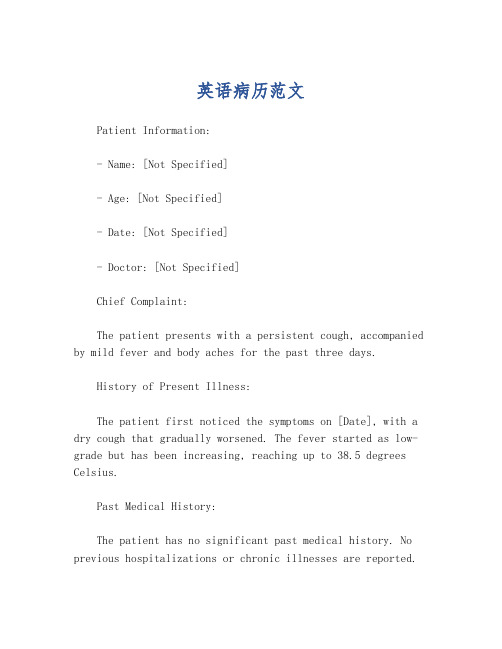
英语病历范文Patient Information:- Name: [Not Specified]- Age: [Not Specified]- Date: [Not Specified]- Doctor: [Not Specified]Chief Complaint:The patient presents with a persistent cough, accompanied by mild fever and body aches for the past three days.History of Present Illness:The patient first noticed the symptoms on [Date], with a dry cough that gradually worsened. The fever started as low-grade but has been increasing, reaching up to 38.5 degrees Celsius.Past Medical History:The patient has no significant past medical history. No previous hospitalizations or chronic illnesses are reported.Medications:The patient has not taken any medications for the current illness, nor are they on any regular medication.Allergies:No known allergies to medications or environmental factors.Physical Examination:Vital signs: Temperature 38.3°C, Puls e 92 bpm, Respiratory rate 20 breaths per minute, Blood pressure 120/80 mmHg. The patient appears fatigued but in no acute distress. Lungs are clear to auscultation with no wheezing or crackles. The throat is slightly red without exudates.Assessment:Based on the symptoms and physical examination, the patient is likely suffering from a viral upper respiratory infection.Plan:1. Hydration and rest are recommended.2. Over-the-counter fever reducers and cough suppressants may be used as needed for symptomatic relief.3. If symptoms persist or worsen, the patient should return for further evaluation and potential testing for influenza or COVID-19.Follow-up:The patient is advised to follow up in one week if symptoms have not improved or if new symptoms develop.Instructions:- Increase fluid intake to prevent dehydration.- Avoid contact with others to prevent the spread of the infection.- Monitor for signs of worsening condition, such as difficulty breathing, persistent high fever, or chest pain.Note: This is a hypothetical patient case and should not be used as a substitute for professional medical advice, diagnosis, or treatment.。
Admission Notes英文版病例 英语病历
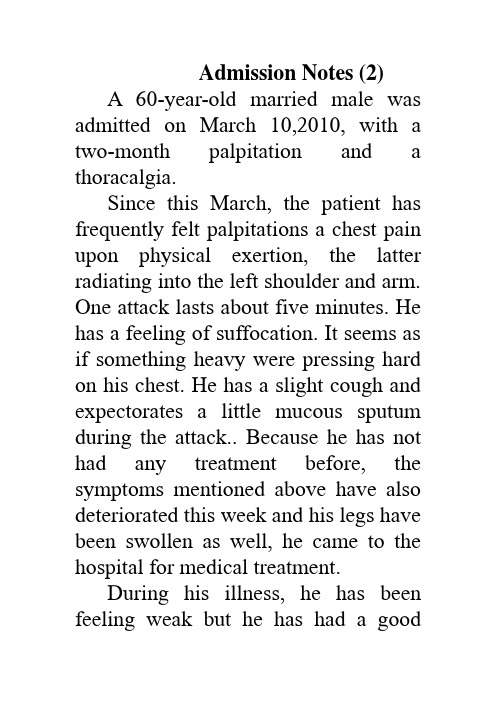
Admission Notes (2)A 60-year-old married male was admitted on March 10,2010, with a two-month palpitation and a thoracalgia.Since this March, the patient has frequently felt palpitations a chest pain upon physical exertion, the latter radiating into the left shoulder and arm. One attack lasts about five minutes. He has a feeling of suffocation. It seems as if something heavy were pressing hard on his chest. He has a slight cough and expectorates a little mucous sputum during the attack.. Because he has not had any treatment before, the symptoms mentioned above have also deteriorated this week and his legs have been swollen as well, he came to the hospital for medical treatment.During his illness, he has been feeling weak but he has had a goodappetite, and his bowel motions and micturition have remained normal.He said that he had been perfectly healthy and had never had rheumatic fever or heart trouble previously.There is nothing particular in his family medical history.PE T: 36.7”C; P:100/min. R:20/min.;BP:140/80mmHg(19—11kPa).Well developed and nourished. In his right mind and in voluntary position. No dyspnea or cyanosis detected. No eruption or purpura over skin. Superficial lymph nodes impalpable. Skull and head organs not abnormal. Neck soft and supple and free of venous engorgement. Trachea in midline. Thyroid not enlarged. Chest symmetrical. Lungs clear. Heart enlarged and leftward without irregular beats. Heart rate 100/min. A grade—IIIharsh blowing systolic murmur heard at the apical area with no thrill felt or diastolic murmur heard. Abdomen flat with no tenderness. Liver felt 2 fb below costal margin. Hepatojugular reflux negative. Spleen not palpable. No shifting dullness over abdomen heard. Slight edema in both ankles present. Bilateral knee jerk reflexes active. No pathological neural reflex found.Chest fluoroscopy reveals general cardiac enlargement.ECG shows:1.sinus rhythm2.left ventricular hypertrophy3.chronic coronary insufficiency Diagnosis: Coronary Heart Disease Left V entricular HypertrophyAngina Pectoris Signature: Date:。
病历书写(英文)

5
Basic requirement for the history record
1. To be well organized and canonical 2. No much erasion and gride could be done in the
4
How to make a good history record
1. Order is imperative 2. Keep items of history in the history 3. Describe specifically any pertinent negative
information 4. Data not recorded are data lost 5. Use short words instead of long and probably fancier
HISTORY RECORD
1
What is history record
The clinical record documents the patient's history and physical findings. It shows how clinicians assess the patient, what plans they make on the patient's behave, what actions they take, and how the patient responds to their efforts .
病历英语作文最简单三个步骤

病历英语作文写作的三步走策略In the medical field, a patient's medical record is a crucial document that provides a detailed overview of their health status, diagnosis, and treatment plan. When it comes to writing a medical record in English, simplicity and clarity are essential. Here's a three-step approach to writing a basic medical record in English:**Step 1: Gathering Information** The first step is to gather all the necessary information about the patient's health condition. This includes details such as thepatient's name, age, gender, and contact information. Additionally, it's important to record the patient's chief complaint, which is the main reason for their visit to the doctor. Other relevant information may include thepatient's past medical history, family history, and any allergies or medications they are currently taking.**Step 2: Writing the Medical Record** Once you have gathered all the necessary information, it's time to start writing the medical record. Begin by introducing thepatient and providing a brief overview of their condition. Then, focus on the chief complaint and provide a detaileddescription of the patient's symptoms, including their duration, severity, and any associated factors.Next, outline the doctor's diagnosis and explain the reasoning behind it. Include any relevant tests or procedures that were performed to confirm the diagnosis. Finally, describe the treatment plan, including any prescribed medications, recommended lifestyle changes, or follow-up appointments.**Step 3: Review and Editing** After writing the medical record, it's crucial to review and edit it for clarity and accuracy. Check for any grammatical errors or typos that may have crept in. Ensure that all information is complete and accurate, and that it flows smoothly from one section to the next. It's also important to ensure that the medical terminology is used correctly and that the language is easy to understand for non-medical readers.**中文内容****病历英语作文的三步走策略**在医学领域,病历是患者健康状况、诊断以及治疗计划的重要文件。
怎样写英文病历

How to write patient's case history怎样写英文病历PATIENT HISTORY病史A detailed patient history and physical exam form the foundation of patient uation and vital patient data that enables efficient, quality patient rounds.一份详细的病史和体检是评估患者的基础,也可为组织高质量、高效率的查房提供重要的资料。
On the other hand, a poorly documented history and physical may leads to confusion, serious omission of vital data and inefficiency on patient rounds. In this age of modern technology with equipment such as CT, MRI and PET scanners, the history and physical exam seem to be slowly evolving into a relic of a past era! Both attending physicians as well as residents in training seem to rely more heavily on laboratory and imaging modalities than history to establish the diagnosis. “However no part of the patient uation is more essential to diagnosis than the patient history. The importance of skillful data collection is underscored by the widely accepted understanding that the medical history contributes 60% to 80% of the information needed for accura te diagnoses.” Thus to neglect the patient history denies the physician of a “vital” diagnostic tool.另一方面,写得差的病史和体检可能会引起混淆,导致重要资料的遗漏和查房效率的低下。
英语病历书写-英语病例写作方法-入院记录
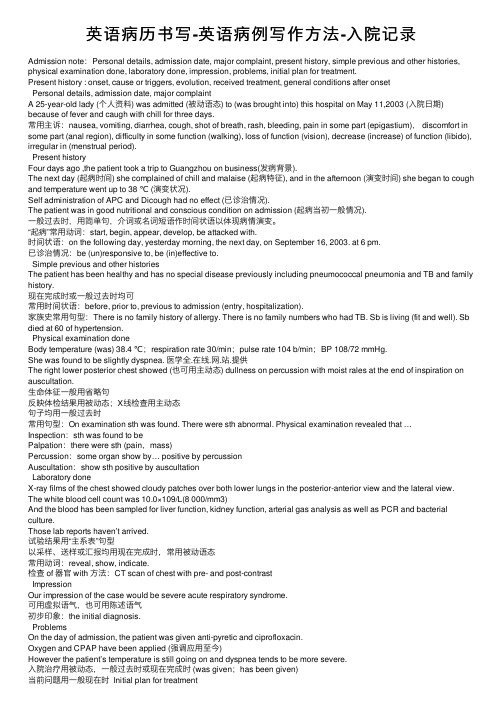
英语病历书写-英语病例写作⽅法-⼊院记录Admission note:Personal details, admission date, major complaint, present history, simple previous and other histories, physical examination done, laboratory done, impression, problems, initial plan for treatment.Present history : onset, cause or triggers, evolution, received treatment, general conditions after onsetPersonal details, admission date, major complaintA 25-year-old lady (个⼈资料) was admitted (被动语态) to (was brought into) this hospital on May 11,2003 (⼊院⽇期) because of fever and caugh with chill for three days.常⽤主诉:nausea, vomiting, diarrhea, cough, shot of breath, rash, bleeding, pain in some part (epigastium), discomfort in some part (anal region), difficulty in some function (walking), loss of function (vision), decrease (increase) of function (libido), irregular in (menstrual period).Present historyFour days ago ,the patient took a trip to Guangzhou on business(发病背景).The next day (起病时间) she complained of chill and malaise (起病特征), and in the afternoon (演变时间) she began to cough and temperature went up to 38 ℃ (演变状况).Self administration of APC and Dicough had no effect (已诊治情况).The patient was in good nutritional and conscious condition on admission (起病当初⼀般情况).⼀般过去时,⽤简单句,介词或名词短语作时间状语以体现病情演变。
英文病历格式
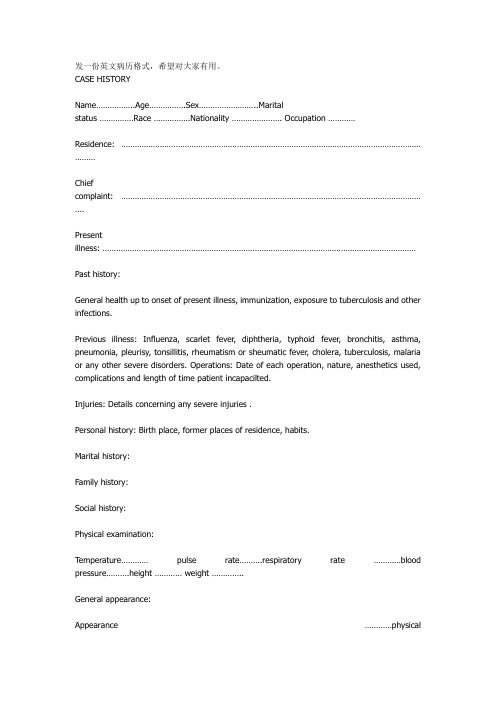
发一份英文病历格式,希望对大家有用。
CASE HISTORYName……………..Age…………….Sex……………………..Maritalstatus ……………Race …………….Nationality …………………. Occupation …………Residence: ……………………………………………………………………………………………………………………………Chiefcomplaint: ……………………………………………………………………………………………………………………….Presentillness: …………………………………………………………………………………………………………………………Past history:General health up to onset of present illness, immunization, exposure to tuberculosis and other infections.Previous illness: Influenza, scarlet fever, diphtheria, typhoid fever, bronchitis, asthma, pneumonia, pleurisy, tonsillitis, rheumatism or sheumatic fever, cholera, tuberculosis, malaria or any other severe disorders. Operations: Date of each operation, nature, anesthetics used, complications and length of time patient incapacilted.Injuries: Details concerning any severe injuries .Personal history: Birth place, former places of residence, habits.Marital history:Family history:Social history:Physical examination:Temperature………… pulse rate……….respiratory rate …………blood pressure……….height ………… weight …………..General appearance:Appearance …………physicaldevelopment ……………..nutrition………………..status………….posture…………..gait…Tremors or other abnormal movements.Mental status:degree of consciousness…………….cooperation…………….orientation…………emotional state…………………Skincolor…………..texture…………….moisture………..hair-distribution…………character of scalp………………..Face:appearance…………color………..tenderness………………abnormal movements………………Eyes:Brows……….lids………..vision…………….eyeballmotion ………….prominence……………..tension……conjunctivae………sclerae……..corneae………..irises………….pupils……………..size……………shape………….regularity ……………….reactions……………fields………………fundi……………Ears:appearance……hearing…….tenderness………….discharge……….drums ……………canals…………….postauricular swelling or tenderness………………………..Nose:appearance ……..discharge………………nasal cavity …………septum………….transillumination……………..smell…….Mouth:Breath……………lips …………color…………fissure………….lesions…………………Tongue:tremor…..deviation………..color……..moisture……….texture……………..Gingivae:color…………….texture……….recession…………bleeding…………….Lesions:Teeth-number………….condition…………dentures…………….buccal mucus color………….eruptions…….lesions……Throat:palate and uvula ……………….pillars………..tonsils…………poster ior pharynx………larynx…………..Neck:lymphnodes…………….scars………thyroid……….salivaryglands……….position……….motion………veins…..pulsation…edema……..trachea……………..Shoulder girdle:deformity……….swelling………….tenderness………….freedom of movements………….muscle spasm……………….supraclavicular or infraclavicular lymphnodes………………………Arms and Hands:position……..deformities…………color………………….tenderness……………muscle strength………………. abnormal motions……………..joints: edema………… freedom of movements…….temperature…………moisture………..local swellings……….vessels ………….epitrochlear lymphnodes………fingers………….nails …………..reflexes………………..Breasts:size………contour……….tenderness…………….masses……….glandular consistency………nipples…………skin color……………texture……………retraction………..Axillae:skin……….hair……..lymphnodes……….Back:deformities………freedom of movements…….skin ……….swelling…….tenderness…………muscle spasm………..scapulae………..Thorax:shape……..respiratory movements……….swelling….pulsation……………Heart:apex impulse location…………character………..thrill…………..measurements: right border…….left border……….supracardiac dullness………..mid clavicular ilne………souds-rate…..rhythm………..intensity……..quality of murmurs………..pulses………..character……….condition of temporal, brachial, radial vessels……………….Lungs:resonance………..diaphragmatic excursion……………tactile fremitus……….. breath sounds………….whispered voic sounds……..spoken voice sounds……rales………..Abdomen:size………shape…….scars …………tension…….percussion note……………masses tenderness……….spasm………….pulsation……….umbilicus…….fluid wave………..shifting dullness………liver-dulness……….edge……..spleen ………….kidneys………..costovertebral tenderness………herniae ……………peristalsis: audible …..visible……bladder-dulness………..palpable distension……inguinal lymphnodes…..reflexes……Legs and Feet:Position…………deformities……….color……………..tenderness…………muscle strength………….abnormal motions………..freedom of movements….joints ……edema……..temperature…………moisture…………local swellings………ulcerations…………vessels…………arches……….toes..Nails…….reflexes……..clonus………Kerning…….Romberg…….Male Genitalia:Pubic hair………penis………..scrotum………testicles…….epididymis……….cords………………..Female Genitalia:pubic hair…..vulva……..vagina…….perineum……..cervix………..fundus…………..vaults…….Rectum:anal orifice….sphincter tone…..fissures…………hemorrhoids………..tenderness……………internal obstruction …..masses…….prostate…..tenderness….Other abnormal findings:…………Recapitulation of important variants:……….Impression…….Signature………………。
英语写病历作文模板
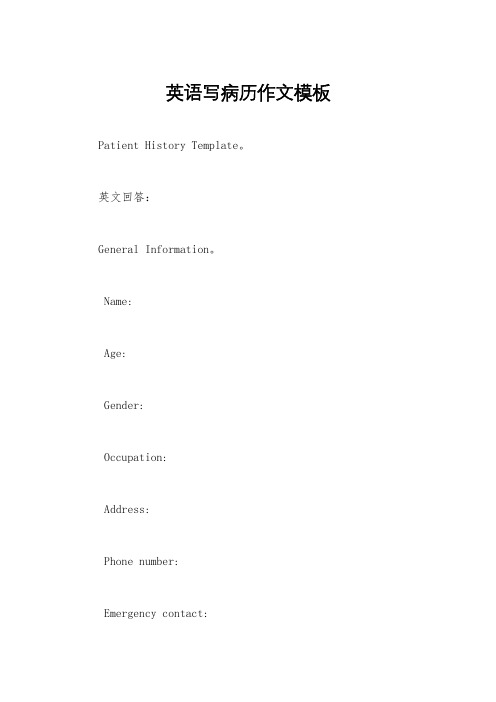
英语写病历作文模板 Patient History Template。
英文回答:General Information。
Name:Age:Gender:Occupation:Address:Phone number:Emergency contact:Medical History。
Past medical history: List any previous illnesses, surgeries, hospitalizations, or accidents.Family medical history: Note any history of chronic diseases, such as heart disease, cancer, or diabetes, in the patient's family.Allergies: List any known allergies to medications, foods, or other substances.Medications: List all current medications, including prescription drugs, over-the-counter medications, and herbal supplements.Social history: Discuss the patient's lifestyle, including diet, exercise, smoking, alcohol use, and drug use.Present Illness。
Chief complaint: State the patient's primary reasonfor seeking medical attention.History of present illness: Describe the onset, duration, severity, and progression of the patient's symptoms.Physical Examination。
英文病历撰写手记
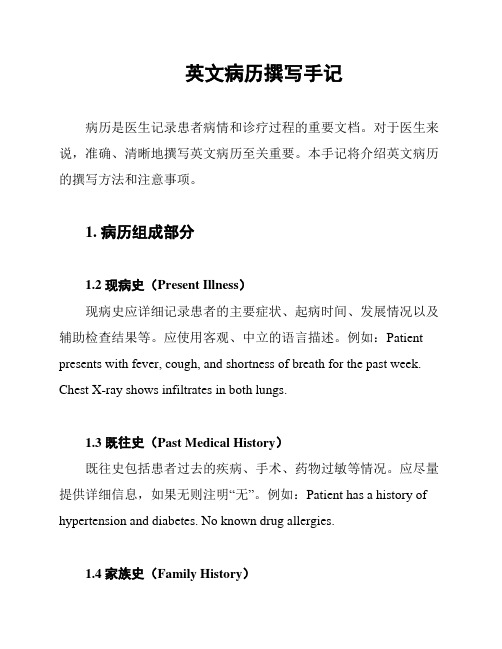
英文病历撰写手记病历是医生记录患者病情和诊疗过程的重要文档。
对于医生来说,准确、清晰地撰写英文病历至关重要。
本手记将介绍英文病历的撰写方法和注意事项。
1. 病历组成部分1.2 现病史(Present Illness)现病史应详细记录患者的主要症状、起病时间、发展情况以及辅助检查结果等。
应使用客观、中立的语言描述。
例如:Patient presents with fever, cough, and shortness of breath for the past week. Chest X-ray shows infiltrates in both lungs.1.3 既往史(Past Medical History)既往史包括患者过去的疾病、手术、药物过敏等情况。
应尽量提供详细信息,如果无则注明“无”。
例如:Patient has a history of hypertension and diabetes. No known drug allergies.1.4 家族史(Family History)家族史包括患者家庭成员的疾病情况,特别是与患者当前问题相关的疾病。
例如:Patient's mother has a history of breast cancer.1.5 个人史(Social History)个人史包括患者的生活方式、吸烟、饮酒、嗜好、职业等信息。
例如:Patient is a non-smoker and consumes alcohol occasionally.1.6 体格检查(Physical Examination)体格检查应记录医生对患者进行的全面检查,包括体温、脉搏、呼吸、血压等指标。
应详细描述发现的异常情况。
例如:Vital signs: temperature 37.5°C, heart rate 82 bpm, respiratory rate 18 breaths per minute, blood pressure 120/80 mmHg. Chest auscultation reveals decreased breath sounds in the lower left lung field.1.7 辅助检查(Laboratory and Diagnostic Tests)1.8 诊断(Diagnosis)1.9 治疗(Treatment)治疗部分应详细记录医生针对患者病情制定的治疗计划,包括药物治疗、手术、物理疗法等。
如何写英文病历
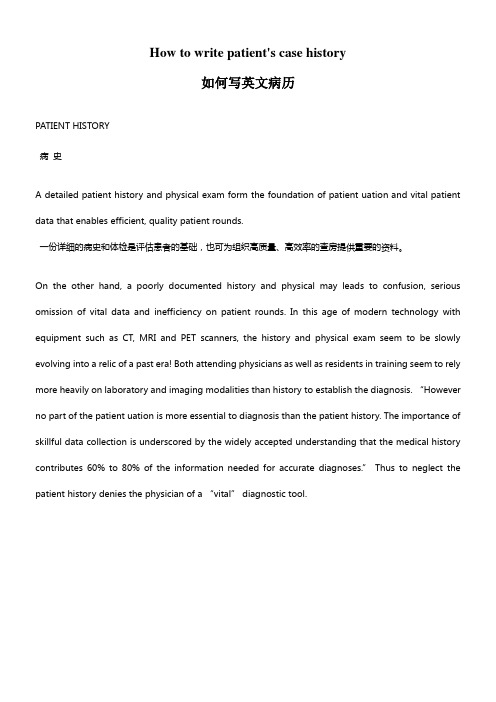
How to write patient's case history如何写英文病历PATIENT HISTORY病史A detailed patient history and physical exam form the foundation of patient uation and vital patient data that enables efficient, quality patient rounds.一份详细的病史和体检是评估患者的基础,也可为组织高质量、高效率的查房提供重要的资料。
On the other hand, a poorly documented history and physical may leads to confusion, serious omission of vital data and inefficiency on patient rounds. In this age of modern technology with equipment such as CT, MRI and PET scanners, the history and physical exam seem to be slowly evolving into a relic of a past era! Both attending physicians as well as residents in training seem to rely more heavily on laboratory and imaging modalities than hi story to establish the diagnosis. “However no part of the patient uation is more essential to diagnosis than the patient history. The importance of skillful data collection is underscored by the widely accepted understanding that the medical history contri butes 60% to 80% of the information needed for accurate diagnoses.” Thus to neglect the patient history denies the physician of a “vital” diagnostic tool.另一方面,写得差的病史和体检可能会引发混淆,致使重要资料的遗漏和查房效率的低下。
英语病历模板范文
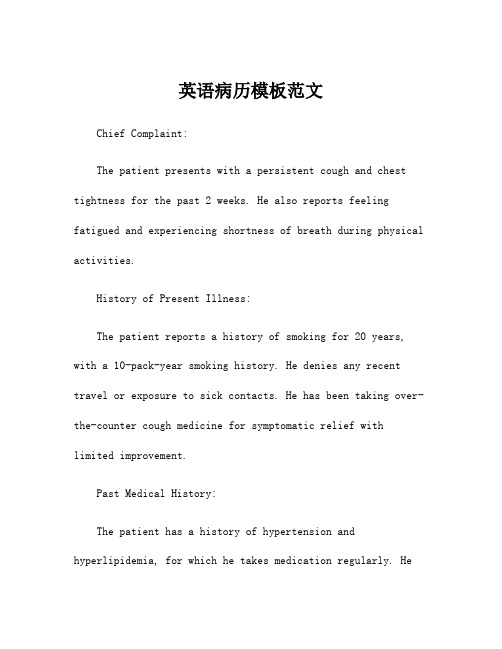
英语病历模板范文Chief Complaint:The patient presents with a persistent cough and chest tightness for the past 2 weeks. He also reports feeling fatigued and experiencing shortness of breath during physical activities.History of Present Illness:The patient reports a history of smoking for 20 years, with a 10-pack-year smoking history. He denies any recent travel or exposure to sick contacts. He has been taking over-the-counter cough medicine for symptomatic relief withlimited improvement.Past Medical History:The patient has a history of hypertension and hyperlipidemia, for which he takes medication regularly. Healso reports a past history of seasonal allergies and occasional sinus infections.Family History:There is a family history of cardiovascular disease, with the patient's father suffering from a heart attack at the age of 55.Physical Examination:Vital signs on presentation were stable with a blood pressure of 130/80 mmHg, pulse rate of 80 beats per minute, respiratory rate of 18 breaths per minute, and oxygen saturation of 98% on room air. Lung auscultation revealed bilateral scattered wheezes and diminished breath sounds in the lower lung fields.Assessment and Plan:Based on the patient's presenting symptoms and physical examination findings, the working diagnosis is exacerbationof chronic obstructive pulmonary disease (COPD). The plan includes initiating bronchodilators, corticosteroids, and supplemental oxygen therapy. A chest X-ray will be ordered to rule out any acute pathology. Patient education on smoking cessation will be provided, and a follow-up appointment in 2 weeks for reassessment of symptoms will be scheduled.。
- 1、下载文档前请自行甄别文档内容的完整性,平台不提供额外的编辑、内容补充、找答案等附加服务。
- 2、"仅部分预览"的文档,不可在线预览部分如存在完整性等问题,可反馈申请退款(可完整预览的文档不适用该条件!)。
- 3、如文档侵犯您的权益,请联系客服反馈,我们会尽快为您处理(人工客服工作时间:9:00-18:30)。
How to write patient's case history怎样写英文病历PA TIENT HISTORY病史A detailed patient history and physical exam form the foundation of patient uation and vital patient data that enables efficient, quality patient rounds.一份详细的病史和体检是评估患者的基础,也可为组织高质量、高效率的查房提供重要的资料。
On the other hand, a poorly documented history and physical may leads to confusion, serious omission of vital data and inefficiency on patient rounds. In this age of modern technology with equipment such as CT, MRI and PET scanners, the history and physical exam seem to be slowly evolving into a relic of a past era! Both attending physicians as well as residents in training seem to rely more heavily on laboratory and imaging modalities than history to establish the diagnosis. “However no part of the patient uation is more essential to diagnosis than the patient history. The importance of skillful data collection is underscored by the widely accepted understanding that the medical history contributes 60% to 80% of the information needed for accura te diagnoses.” Thus to neglect the patient history denies the physician of a “vital” diagnostic tool.另一方面,写得差的病史和体检可能会引起混淆,导致重要资料的遗漏和查房效率的低下。
在这个具有现代化设备如CT、MRI、PET的年代里,病史和体格检查似乎已慢慢地成为一种历史遗物。
无论是主治医生或住院医生都似乎越来越依赖于实验室和影像学检查而不是病史来明确诊断。
然而对诊断来说,没有一种评估手段比病人的病史更重要。
尽管普遍认为病史可提供准确诊断所需的60%一80%的信息,但有效地收集资料的技能仍被低估了。
所以若忽略了患者的病史就意味着剥夺了医生的一种最重要的诊断工具。
The basic outline structure for the patient history and physical exam usually includes the following: Identification: patient name, age, gender, race, and occupationChief Complaint: (in the patient’s words)HPI: (history of present illness)PMHx: (past medical history)Medications: should include current meds as well as medication allergies病史和体格检查的基本框架内容通常包括以下内容:身份证明:患者姓名,年龄,性别,种族和职业主述:(用患者的话表达)HPI:现病史PMHx:过去史药物史:包括现在使用的药物以及药物过敏史ROS: review of systemsSocial Hx.: includes family situation (married, divorced, single), habits; cigarettes, alcohol or illicit drug use, sexual behaviorPhysical Exam:Impression/Diagnosis:Treatment Plan:ROS:系统回顾社会史:包括婚姻状态(已婚、离婚、单身)、习惯、吸烟、饮酒或吸毒、冶游史体格检查:诊断:治疗方案:Self- introduction: Upon arrival at the patient's bedside, the physician should first try to establish rapport with the patient by using “nonverbal cues”such as maintaining eye contact or extending a hand to shake the patient’s hand (if “culturally”acceptable). The physician or student should first introduce him or herself and state their reason for the visit. Also, they should ask the patient’s permission to interview them.自我介绍:到达病人床边时,医生应通过非言语的方式如保持视线的接触或伸手去和病人握手(如果风俗上可以接受)来与病人建立融洽的关系。
医生或医学生首先应自我介绍并解释来看病人的原因,并且应在交流前取得病人的同意。
Here are a few specific points about each section of the history outline:1. Identification -- This should include the patient's name, age, sex, race and occupation for example: “Mr. Jones is a 55 yr. Old Caucasian male who works as a farmer.”The patient’s name written in the history allows future interviewers to address the patient by his name which conveys a sense of patient respect. The age, race, sex and occupation are an important as many diseases are not only gender and age dependent, but may also occur more commonly in specific ethnic and occupation groups.以下是病史相关部分的说明:1. 身份证明--这应该包括病人的姓名、年龄、性别、种族和职业。
比如“琼斯先生是一位55岁的白人男性,职业是农民”。
在病史中写明患者的姓名有利于以后的人员用病人的姓名来和他打招呼,这样会使病人产生一种受尊重感。
年龄、种族、性别、和职业都非常重要,因为许多疾病不仅与性别和年龄有关,并且在特定的种族或职业人群中更为常见。
2. Chief complaint -- This should be written in the patient’s words. For example “chest pain”rather than “angina”. Also the duration of the chief complaint should be noted “chest pain for 1 hour”. Before moving on to the HPI, it would be appropriate to perform a “survey of problems”asking the patient if there are any other current problems bothering them. Once these have been listed, the interviewer can come back to the original Chief Complaint the patient presented with and obtain the details in the HPI. However “associated”symptoms should be descried in the HPI.2. 主述--主述应该用病人的语言来写。
比如“胸痛”而不是“心绞痛”。
而且应同时写明主诉的时间如“胸痛1小时”。
在开始采集现病史之前,应补充问病人是否还有其他不适症状。
一旦发现有其他症状应补充到主诉中,并在现病史中详细描述。
但伴随症状应在现病史中描述。
3. HPI (History of Present Illness) --The history of the present illness is a more elaborate description of the patient’s chief complaint and is the most important structural element of the medical history. This section should give the following details about the chief complaint (s): 3. 现病史--“现病史是对病人主诉更为详细的描述,是病史中最为重要的组成部分。
”在这部分中应对主诉从以下几个方面加以详细描述。
a. Detailed description of the “chief complaint”; “a dull crushing chest pain”including body location of the complaint.b. A chronological history and sequence of the chief complaint.c. What circumstances precipitated it: climbing stairs, emotional upset such as anger, or sexual intercourse.d. What circumstances relieve it: resting for a few minutes.a.对“主诉”更为详细地描述;如“压榨样胸部闷痛”,应包括主诉的部位。
